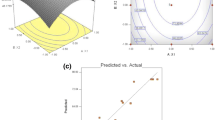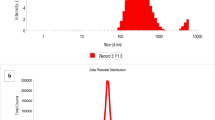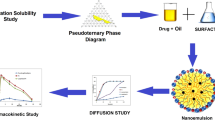Abstract
The present study aimed to develop an ideal nanostructured delivery (propylene glycol monocaprylate-polycaprolactone core–shell nanostructures) for a poorly soluble drug by quality-by-design (QbD) approach. Carvedilol (CVD) loaded polymeric nanocapsules were formulated by 32 factorial designs and established the functional relationships between the operating independent variables. An increase in polycaprolactone (PCL) content led to a rise in mean particle size, while the effect of Lutrol F127 was found statistically insignificant. Furthermore, it was observed that as the level of Lutrol F127 increases zeta potential decreases. However different levels of PCL did not significantly affected the zeta potential. The in vitro release of carvedilol from nanocapsule is contributed by the coupling of diffusion and erosion mechanism. Scanning electron microscopy, transmission electron microscopy (TEM) and atomic force microscopy (AFM) images showed the spherical nature of prepared optimized formulations OF1–OF3. TEM images illustrated spherical nanocapsules with a clearly distinctive oil core and PCL coating. The thickness of the core varied from 14.78 to 54.21 nm. The smooth surface of nanocapsules observed under AFM studies indicated no surface crystallization of CVD or other excipients used in preparing optimized formulations. The root mean square roughness and the average volume of optimized nanocapsules (OF1–OF3) ranged between 14.42–23.26 nm and 24.41–49.91 µm3, respectively. This study revealed the effectiveness of QbD for the preparation of optimized nanocapsules of CVD having desired attributes in the shortest possible time.










Similar content being viewed by others
References
Alanazi FK, Haq N, Radwan AA, Alsarra IA, Shakeel F (2014) Potential of lipid nanoemulsion for drug delivery of cholesteryl-hexahydrophthaloyl-5-fluorouracil. J Drug Deliv Sci Technol 24:459–463
Alexandridis P, Hatton TA (1995) Poly(ethylene oxide)-poly(propylene oxide)-poly(ethylene oxide) block copolymer surfactants in aqueous solutions and at interfaces: thermodynamics, structure, dynamics, and modeling. Coll Surf A 96:1–46
Arifin DY, Lee LY, Wang CH (2006) Mathematical modeling and simulation of drug release from microspheres: implications to drug delivery systems. Adv Drug Deliv Rev 58:1274–1325
Bhagat C, Singh SK, Verma PRP, Singh N, Verma S, Ahsan MN (2013) Crystalline and amorphous carvedilol-loaded nanoemulsions: formulation optimisation using response surface methodology. J Exp Nanosci 8:971–992
Blouza IL, Charcosset C, Sfar S, Fessi H (2006) Preparation and characterization of spironolactone-loaded nanocapsules for paediatric use. Int J Pharm 325:124–131
Cándida L, Laurent MH, Francisco O, José LVJ, Maria JA (1993) Design of new formulations for topical ocular administration: polymeric nanocapsules containing metipranolol. Pharm Res 10:80–87
Couvreur P, Barratt G, Fattal E, Vauthier C (2002) Nanocapsule technology: a review. Crit Rev Ther Drug Carr Syst 19:99–134
Dinesh Kumar V, Verma PRP, Singh SK (2015) Development and evaluation of biodegradable polymeric nanoparticles for the effective delivery of quercetin using a quality by design approach. LWT Food Sci Technol 61:330–338
Farokhzad OC, Langer R (2009) Impact of nanotechnology on drug delivery. ACS Nano 3:16–20
FDA (Food and Drug Administration) (2009) Guidance for Industry. http://www.fda.gov/downloads/Drugs/Guidances/ucm073507.pdf. Accessed on 24 June 2015
Ferranti V, Marchais H, Chabenat C, Orecchioni A, Lafont O (1999) Primidone-loaded poly-ε-caprolactone nanocapsules: incorporation efficiency and in vitro release profiles. Int J Pharm 193:107–111
Fessi H, Puisieux P, Devissaguet JP, Ammoury N, Benita S (1989) Nanocapsule formation by interfacial polymer deposition following solvent displacement. Int J Pharm 55:R1–R4
Ghari T, Mortazavi SA, Khoshayand MR, Kobarfard F, Gilani K (2014) Preparation, optimization, and in vitro evaluation of azithromycin encapsulated nanoparticles by using response surface methodology. J Drug Deliv Sci Technol 24:352–360
Grassi M, Lamberti G, Cascone S, Grassi G (2011) Mathematical modeling of simultaneous drug release and in vivo absorption. Int J Pharm 418:130–141
Grillo R, dos Santos NZP, Maruyama CR, Rosa AH, de Lima R, Fraceto LF (2012) Poly(ε-caprolactone)nanocapsules as carrier systems for herbicides: physico-chemical characterization and genotoxicity evaluation. J Hazard Mater 231–232:1–9
Hamishehkar H, Emami S, Lamei B, Valizadeh H, Jouyban A (2014) Evaluation of solubility and dissolution profile of itraconazole after cogrinding with various hydrophilic carriers. J Drug Deliv Sci Technol 24:653–658
Hiremath JG, Khamar NS, Palavalli SG, Rudani CG, Aitha R, Mura P (2013) Paclitaxel loaded carrier based biodegradable polymeric implants: preparation and in vitro characterization. Saudi Pharm J 21:85–91
Hu TT, Wang JX, Shen ZG, Chen JF (2008) Engineering of drug nanoparticles by HGCP for pharmaceutical applications. Particuology 6:239–251
Javed I, Ranjha NM, Mahmood K, Kashif S, Rehman M, Usman F (2014) Drug release optimization from microparticles of poly(E-caprolactone) and hydroxypropyl methylcellulose polymeric blends: formulation and characterization. J Drug Deliv Sci Technol 24:607–612
Kallakunta VR, Eedara BB, Jukanti R, Ajmeera RK, Bandari S (2013) A Gelucire 44/14 and labrasol based solid self emulsifying drug delivery system: formulation and evaluation. J Pharm Investig 43:185–196
Klang V, Valenta C, Matsko NB (2013) Electron microscopy of pharmaceutical systems. Micron 44:45–74
Lee JH, Yeo Y (2014) Controlled drug release from pharmaceutical nanocarriers. Chem Eng Sci 125:75–84
Liu P, Wulf OD, Laru J, Heikkilä T, van Veen B, Kiesvaara J (2013) Dissolution studies of poorly soluble drug nanosuspensions in non-sink conditions. AAPS PharmSciTech 14:748–756
Mateo-Ortíz D, Mota-Aguilar DA, Florián-Algarín MA, Avilés-barreto SL, Méndez R, Velázquez C (2012) Motivating K-12 students to study pharmaceutical engineering using guided hands-on visits. Educ Chem Eng 7:e219–e229
Mittal G, Kumar NMVR (2009) Impact of polymeric nanoparticles on oral pharmacokinetics: a dose-dependent case study with estradiol. J Pharm Sci 98:3730–3734
Moghimi SM, Hunter AC (2000) Poloxamers and poloxamines in nanoparticle engineering and experimental medicine. Trends Biotechnol 18:412–420
Molpeceres J, Guzman M, Aberturas MR, Chacon M, Berges L (1996) Application of central composite designs to the preparation of polycaprolactone nanoparticles by solvent displacement. J Pharm Sci 85:206–213
Plapied L, Duhem N, des Rieux A, Préat V (2011) Fate of polymeric nanocarriers for oral drug delivery. Curr Opin Coll Interface Sci 16:228–237
Praveen R, Singh SK, Verma PRP, George JK (2014a) Sustained delivery of cefdinir to upper gastrointestinal tract using calcium alginate beads: a formulation by design. J Pharm Investig 44:455–463
Praveen R, Verma PRP, Singh SK, George JK (2014b) Cross linked alginate gel beads as floating drug delivery system for cefdinir: optimization using Box-Behnken design. J Pharm Investig. doi:10.1007/s40005-014-0164-x
Raval A, Parikh J, Engineer C (2010) Mechanism of controlled release kinetics from medical devices, Braz. J Chem Eng 27:211–225
Saini R, Singh SK, Verma PRP (2012) Evaluation of carvedilol-loaded microsponges with nanometric pores using response surface methodology. J Exp Nanosci 9:831–850
Schaffazick SR, Siqueira IR, Badejo AS, Jornada DS, Pohlmann AR, Netto CR (2008) Incorporation in polymeric nanocapsules improves the antioxidant effect of melatonin against lipid peroxidation in mice brain and liver. Eur J Pharm Biopharm 69:64–71
Singh SK, Verma PRP, Razdan B (2009) Development and characterization of a carvedilol-loaded self-microemulsifying delivery system. Clin Res Regul Aff 26:50–64
Singh B, Kapil R, Nandi M, Ahuja N (2011a) Developing oral drug delivery systems using formulation by design: vital precepts, retrospect and prospects. Expert Opin Drug Deliv 8:1341–1360
Singh SK, Verma PRP, Razdan B (2011b) Atomic force microscopy, transmission electron microscopy, and photon correlation spectroscopy: three techniques for rapid characterization of optimized self-nanoemulsiying drug delivery system of glibenclamide, carvedilol, and lovastatin. J Dispers Sci Technol 32:538–545
Tadano S, Giri B (2011) X-ray diffraction as a promising tool to characterize bone nanocomposites. Sci Technol Adv Mater 12:1–11
Tomba E, Facco P, Bezzo F, Barolo M (2013) Latent variable modeling to assist the implementation of quality-by-design paradigms in pharmaceutical development and manufacturing: a review. Int J Pharm 457:283–297
Ubrich N, Schmidt C, Bodmeier R, Hoffman M, Maincent P (2005) Oral evaluation in rabbits of cyclosporin-loaded Eudragit RS or RL nanoparticles. Int J Pharm 288:169–175
Verma S, Singh SK, Verma PRP (2015) Fabrication of lipidic nanocarriers of loratadine for facilitated intestinal permeation using multivariate design approach. Drug Dev Ind Pharm. doi:10.3109/03639045.2015.1052078
Villemson A, Couvreur P, Gillet B, Larionova N, Gref R (2006) Dextran-poly-ε-caprolactone micro- and nanoparticles: preparation, characterization and tamoxifen solubilization. J Drug Deliv Sci Technol 16:307–313
Wang XZ, Liu L, Li RF, Tweedie RJ, Primrose K, Corbett J (2009) Online characterisation of nanoparticle suspensions using dynamic light scattering, ultrasound spectroscopy and process tomography. Chem Eng Res Des 87:874–884
Wang GD, Mallet FP, Ricard F, Heng JY (2012) Pharmaceutical nanocrystals. Curr Opin Chem Eng 1:102–107. doi:10.1016/j.coche.2011.12.001
Acknowledgments
Mr. Jerome K. George thanks Birla Institute of Technology, Mesra, Ranchi, India, to provide senior research fellowship.All the authors (Jerome K George, Sandeep Kumar Singh, and Priya Ranjan Prasad Verma) declare that they have no conflict of interest. This article does not contain any studies with human participants or animals performed by any of the authors.
Author information
Authors and Affiliations
Corresponding author
Rights and permissions
About this article
Cite this article
George, J.K., Singh, S.K. & Verma, P.R.P. Morphological and in vitro investigation of core–shell nanostructures of carvedilol using quality by design. Journal of Pharmaceutical Investigation 45, 561–578 (2015). https://doi.org/10.1007/s40005-015-0204-1
Received:
Accepted:
Published:
Issue Date:
DOI: https://doi.org/10.1007/s40005-015-0204-1




